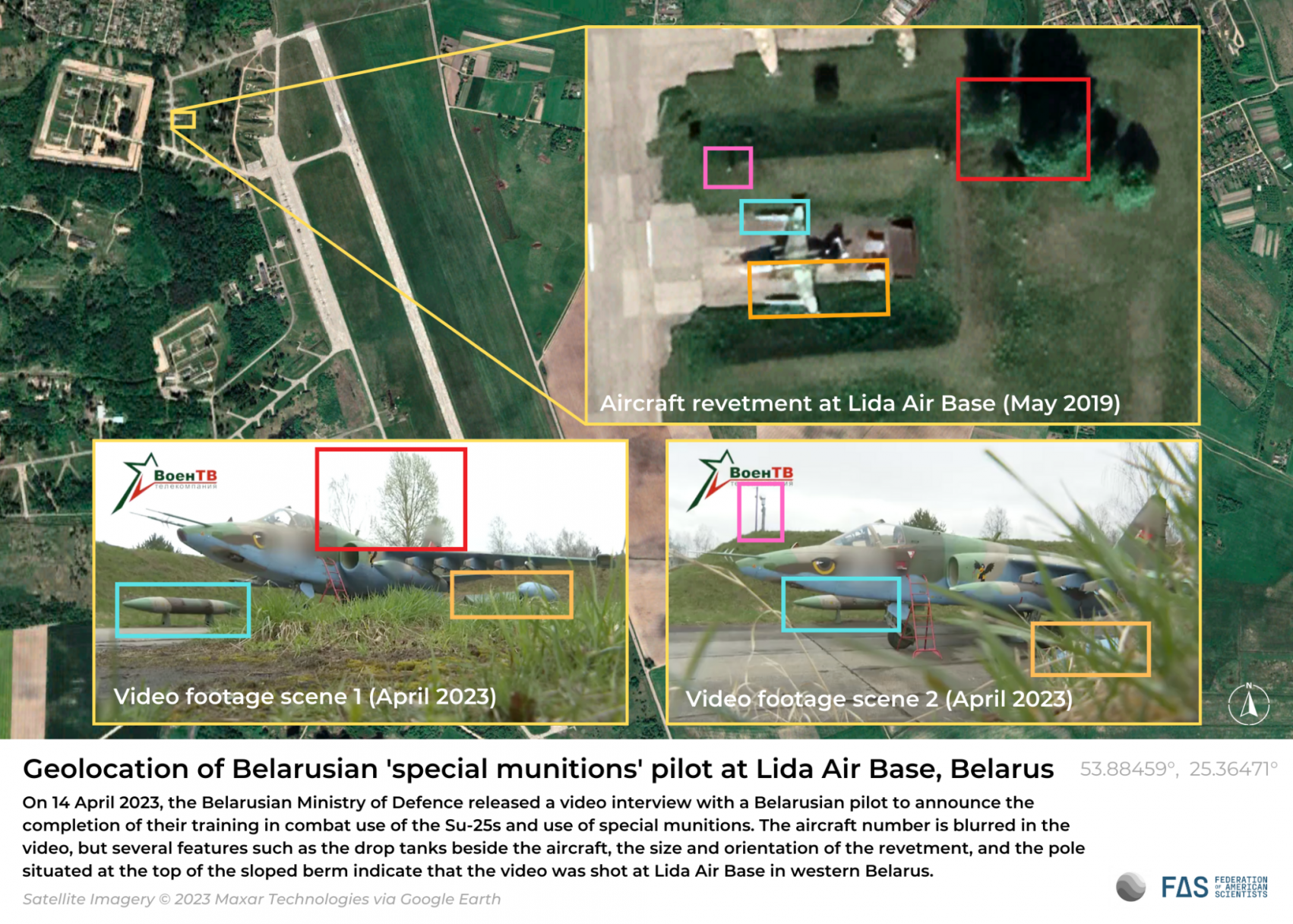
Video Indicates that Lida Air Base Might Get Russian “Nuclear Sharing” Mission in Belarus
On 14 April 2023, the Belarusian Ministry of Defence released a short video of a Su-25 pilot explaining his new role in delivering “special [nuclear] munitions” following his training in Russia. The features seen in the video, as well as several other open-source clues, suggest that Lida Air Base––located only 40 kilometers from the Lithuanian border and the only Belarusian Air Force wing equipped with Su-25 aircraft––is the most likely candidate for Belarus’ new “nuclear sharing” mission announced by Russian President Vladimir Putin.
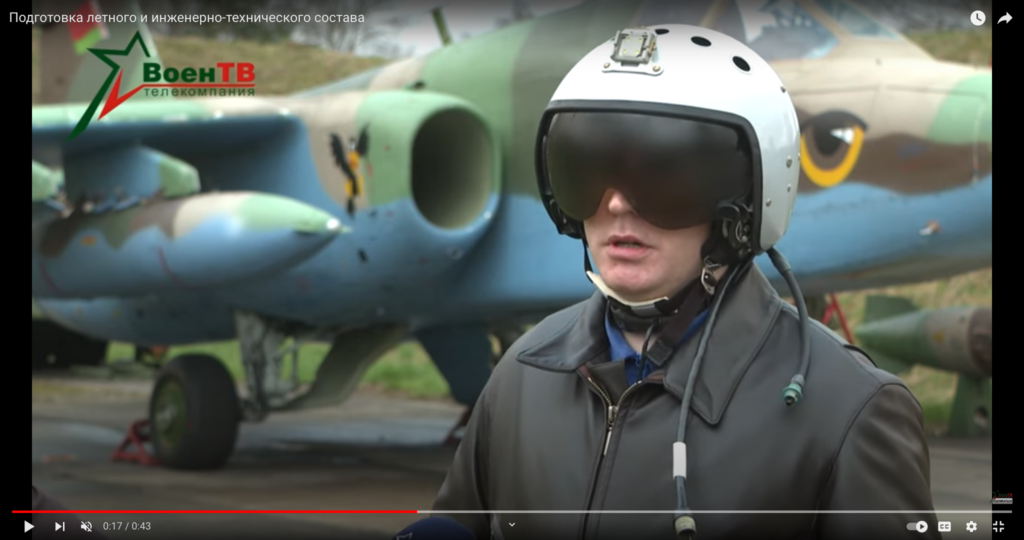
The Belarusian MoD’s military channel features a Belarusian pilot standing in front of a Su-25 aircraft at an unidentified air base.
The video shows the pilot standing in a revetment with a Su-25 in the background. The interview takes place at a grassy location with trees in the distance along with several distinct features, including two drop tanks flanking the Su-25 on either side, and objects behind the aircraft. The revetment itself is also somewhat distinct, as the berm wraps around three sides of the hardstand and the size and orientation of the six rectangular tiles across the opening are clearly visible in the video.
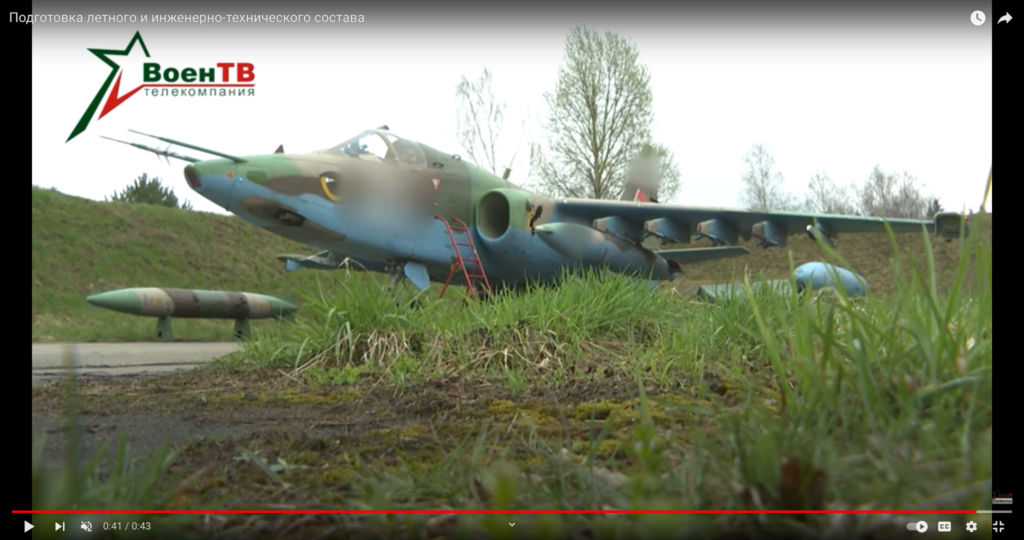
The Belarusian MoD’s video shows a Su-25 aircraft sitting in a revetment surrounded by berms and trees, with drop tanks visible on either side of the aircraft.
Although the pilot is announcing the completion of their training that occured in Russia, the footage was filmed and released by the Belarusian Ministry of Defense. This factor seemed to indicate that the filming location took place in Belarus instead of at the training center in Russia. Additionally, while Su-25s have operated out of other air bases in Belarus throughout the war, including Luninets Air Base, the only Su-25 wing in the Belarusian Air Force is based at Lida.
After analyzing the satellite imagery of other possible candidate hardstands, including those at Luninets and Baravonichi, the video’s signatures appeared to most closely match a specific hardstand found at Lida Air Base. There are multiple revetments on the western side of the base, but the existence and location of a pole on top of one particular sloped berm, as well as the location of the trees in the background, the drop tanks, and the orientation of the tiles on the tarmac all align closely with features from the video footage. While the specific aircraft from the video has yet to be identified (although the individualized camouflage patterns on each Su-25 will help with this process), all of these factors suggest the video was filmed at Lida Air Base.
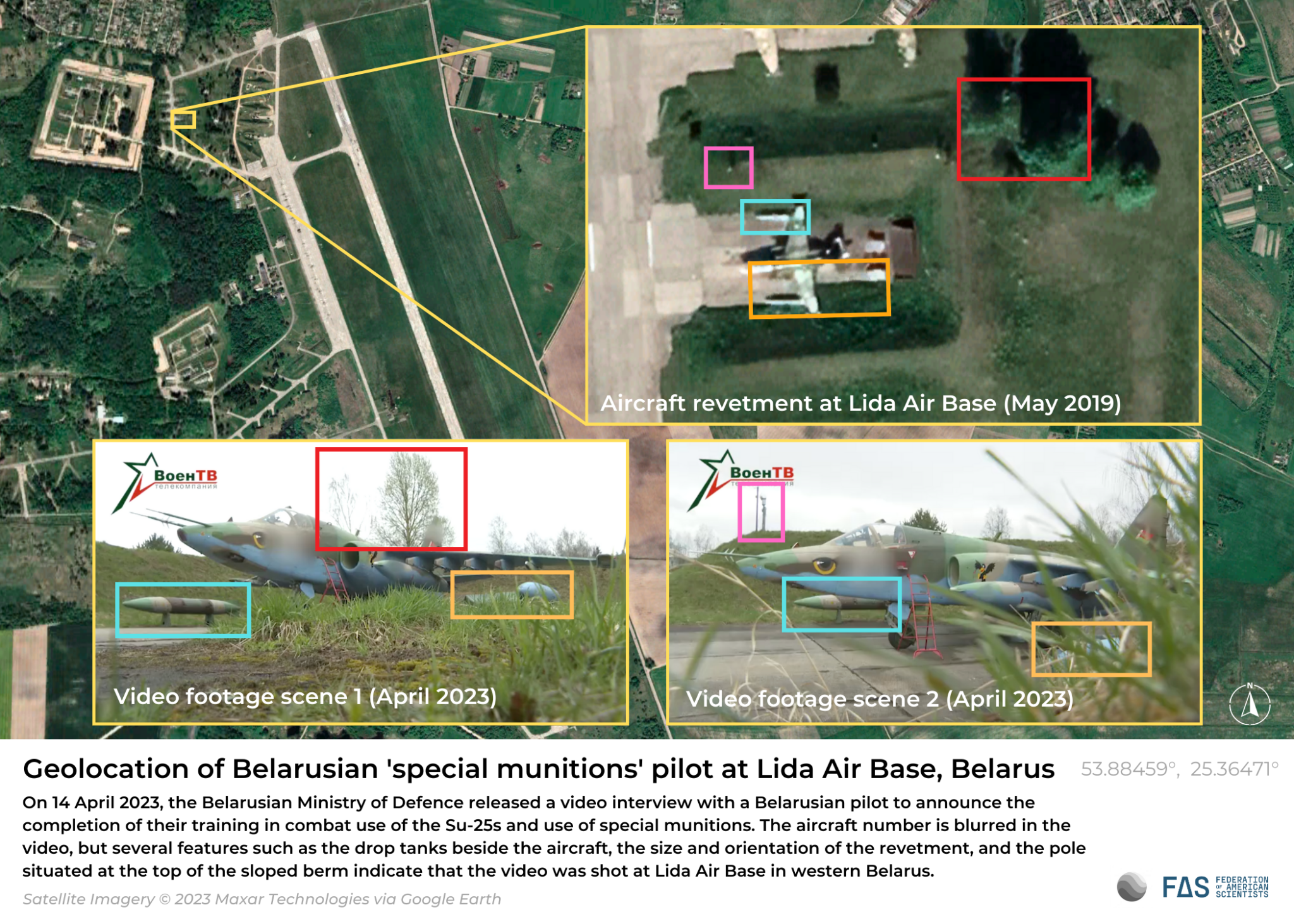
During and immediately after the Cold War, the Lida area was was home to a missile operating base for the 49th Guards Missile Division, first for the SS-4 MRBM, then the SS-20 IRBM, and finally the SS-25 ICBM before the division disbanded in 1997. The former missile operating base is located only ten kilometers south of the air base, and while some areas appear to still be active (perhaps in a civilian or other military role), others appear to be overgrown.
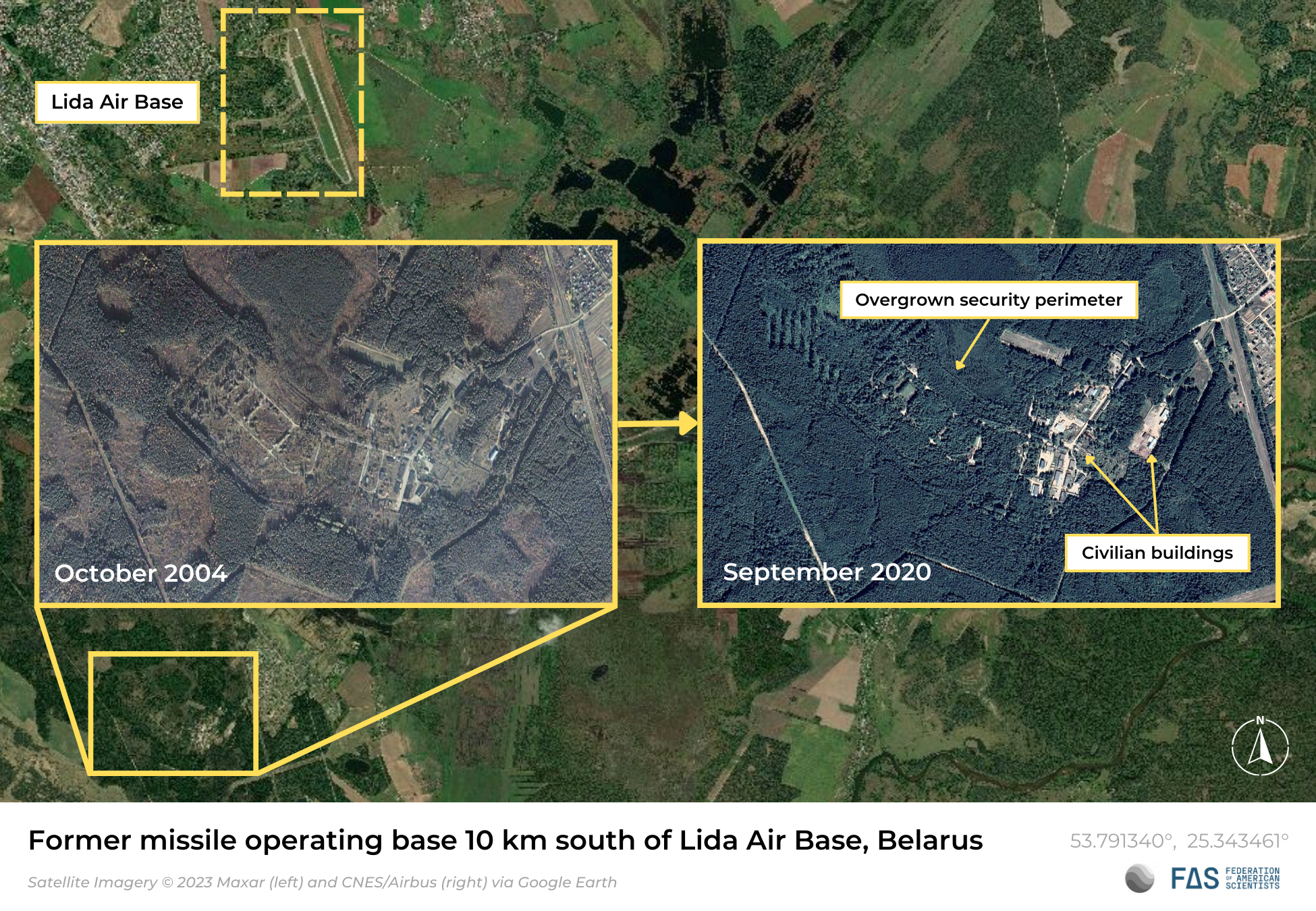
Currently, Lida is home to the Belarusian Air Force’s 116th Guards Assault Aviation Base, which flies the Su-25 Frogfoot––the type of plane confirmed by both the Belarusian Ministry of Defense and President Putin as being newly re-equipped to deliver tactical nuclear weapons. Lida’s Su-25 aircraft have also reportedly been used to conduct strikes in Ukraine.
Two additional data points suggest that Lida is the most likely candidate: on March 25th, Putin announced in an interview with Rossiya 24 that Belarusian crews would begin training in Russia on April 3rd. Belarusian Telegram channels subsequently identified these crews as being from Lida, with one channel stating that “According to my sources, the entire flight and engineering staff of the Lida air base will undergo retraining in Russia” (h/t Andrey Baklitskiy).
In addition, on April 2nd, Russia’s ambassador to Belarus stated that Russian nuclear weapons will be “moved up close to the Western border of our union state” (the supranational union of Russia and Belarus). Although the ambassador declined to offer a more specific location, Lida Air Base is located closer to NATO territory than any other suitable candidate site––only about 40 kilometers from Lithuania’s southern border and approximately 120 kilometers from Poland’s eastern border. Although this would mean a longer journey to transport the nuclear weapons from Russia (and could also make the weapons more vulnerable to NATO strikes), its proximity to Alliance territory would be a clear nuclear signal to NATO.
Challenges for the “nuclear sharing” mission
At the time of publication, it remained highly unclear whether Russia actually intends to deploy nuclear weapons on Belarusian territory, or whether it is developing the infrastructure needed to potentially deploy them in the future. It is clear, however, that such a deployment would likely come with logistical challenges.
President Putin’s March 25th announcement noted that Russia would begin training Belarusian nuclear delivery crews on April 3rd and “on July 1, we [will finish] the construction of a special storage facility for tactical nuclear weapons on the territory of Belarus.” Judging by the April 14th video released by the Belarusian Ministry of Defence, the Belarusian crews completed their training within this short period. This is an extraordinarily fast turnaround for completing the certification process; by contrast, nuclear certification for US/NATO nuclear weapon systems can take months, or even years. And as expert Bill Moon pointed out during a recent roundtable discussion, specialized equipment for warhead transportation and handling would also need to undergo intensive certification processes, which can take months.
Additionally, other Russian nuclear storage sites have taken years to upgrade. Usually, permanent nuclear storage sites in Russia have multi-layered fencing around both the perimeter as well as the storage bunkers themselves inside the complex, which can take months to install. Even a temporary site would still require extensive security infrastructure. Moreover, personnel from the 12th GUMO––the department within Russia’s Ministry of Defence that is responsible for maintaining and transporting Russia’s nuclear arsenal––would also necessarily be deployed to Belarus to staff the storage site (regardless of whether nuclear weapons were present or not) and would need a segregated living space. Bill Moon, who has decades of experience working alongside the 12th GUMO, estimates that this could be a contingent of approximately 100 personnel, including warhead maintainers, guards, and armed response forces. Constructing these kinds of facilities could also take many months to build up, revitalize, and maintain. Although it may be possible to complete construction by Putin’s July 1st deadline, a storage facility would not be ready to actually receive warheads until all of the specialized equipment and personnel were in place.
In order to meet this schedule, as Bill Moon highlighted during the recent roundtable discussion, personnel from the 12th GUMO would have to already be preparing and securing the warhead transportation route, as well as the rail spur used to transfer the warheads from trains to specialized trucks. Lida Air Base has an enclosed rail spur on-site that could potentially be used for this, although it could also require additional security infrastructure. Overall, such a deployment would be quite a difficult task: not only would deploying warheads to Lida Air Base be a very long distance for the warheads and associated equipment to travel, but both the Russian and Belarusian rail networks have experienced significant disruptions due to the war in Ukraine, from both anti-war activists and Ukrainian strikes.
Notably, in May 2022 a Russian anarcho-communist activist group announced that they had sabotaged the rail tracks leading out of the 12th GUMO’s main transit hub at Sergiev Posad in an act of protest against Russia’s invasion of Ukraine. This site would be used to stage and transport specialized storage and warhead handling equipment, such as fencing, vault doors, and environmental control systems––as well as crews––from Russia to Belarus. In particular, the activist group claimed to have used standardized construction tools to unscrew the nuts connecting the rail joints together, thus allowing them to lift and move the rail tracks.
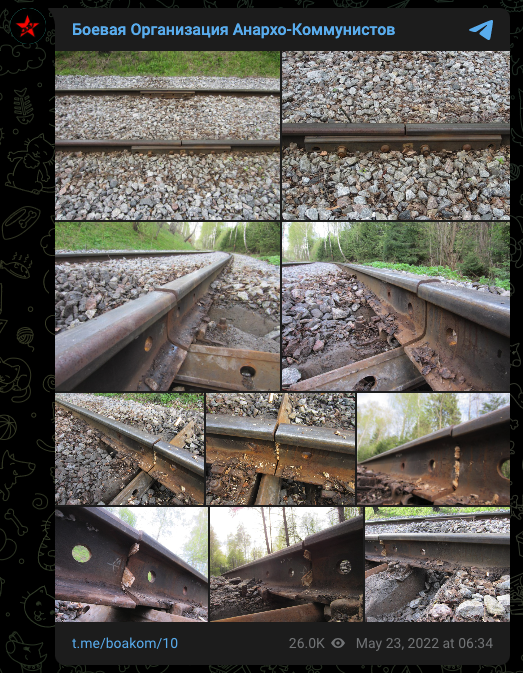
Telegram channel announcing a Russian anarcho-communist group’s successful sabotage of a rail line leading to the 12th GUMO’s main transit hub at Sergiev Posad
The group specifically noted that they wanted to conduct a type of sabotage that was “less visible so the train wouldn’t have time to slow down to a stop.” Given the relative ease with which this attack was conducted, the relative invisibility of the sabotage, and the distance that the warheads and equipment would need to travel to reach Lida or another destination inside Belarus, it is clear that the 12th GUMO’s task of securing the rail lines would be important, yet extremely difficult to accomplish.
Given all of these complexities, if Putin does indeed intend to transfer warheads to Belarus, it is highly unlikely that such a deployment would take place until at least after Putin’s July 1st construction deadline, and it could also be coupled with yet another high-level nuclear signal.
Background Information:
- “United States nuclear weapons, 2023,” FAS Nuclear Notebook, Bulletin of the Atomic Scientists, January 2023.
- “Russian nuclear weapons, 2022,” FAS Nuclear Notebook, Bulletin of the Atomic Scientists, February 2022.
- Status of World Nuclear Forces, Federation of American Scientists
This research was carried out with generous contributions from the John D. and Catherine T. MacArthur Foundation, the New-Land Foundation, Ploughshares Fund, the Prospect Hill Foundation, Longview Philanthropy, the Stewart R. Mott Foundation, the Future of Life Institute, Open Philanthropy, and individual donors.
Satellite imagery has long served as a tool for observing on-the-ground activity worldwide, and offers especially valuable insights into the operation, development, and physical features related to nuclear technology.
This report outlines a framework relying on “Cooperative Technical Means” for effective arms control verification based on remote sensing, avoiding on-site inspections but maintaining a level of transparency that allows for immediate detection of changes in nuclear posture or a significant build-up above agreed limits.
The grant comes from the Carnegie Corporation of New York (CCNY) to investigate, alongside The British American Security Information Council (BASIC), the associated impact on nuclear stability.
Satellite imagery of RAF Lakenheath reveals new construction of a security perimeter around ten protective aircraft shelters in the designated nuclear area, the latest measure in a series of upgrades as the base prepares for the ability to store U.S. nuclear weapons.